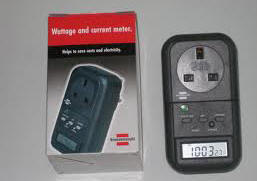|
Fuse and the Earth
Wire - Part II
Objectives
• Be able to calculate the current flowing in an
appliance under normal operating conditions.
• Be able to select the correct fuse for an appliance,
given information about its power rating or the current flowing.
Task 1 - Recap /
Starter
Remind the person next to
you:
• Which part of the appliance
the earth wire is connected to.
• Whether the earth wire has
a low or high resistance.
• How the fuse and earth wire
work together to protect the user.
Task 2
| Your teacher will show you how
to use a "wattage and current meter" and how to select the
correct fuse for an appliance. Use the meter to
complete the table with details of the power and current
flowing through each of the the following appliances: |
 |
|
• Desk Fan
• Electric heater
• Kettle
• Lamp
• Energy
efficient lamp |
Select the correct fuse for each appliance, and fill
in your choice in the final column of the table.
Task 3
When we cannot measure the
current directly we can calculate it from the values of voltage and
power, using the formula below:
|
P
= V × I
|
P =
Power, measured in watts (W).
V = voltage, measured
in volts (V).
I = current,
measured in Amperes (A). |
Calculate the current flowing for the following
devices, and hence select the correct fuse for each device:
|
• A 2.2kW kettle, powered by
mains electricity (230V).
• A 1.2kW heater,
powered by mains electricity (230V).
• A 12V, 55W car
headlight.
• A 7.5kW shower,
powered by mains electricity (230V).
• An 11W energy
efficient lamp, powered by mains electricity.
|
Task 4
Your teacher will explain to
you how to calculate the correct fuse for an appliance. When you
are happy you understand try
these calculations, and select the correct fuse for each appliance
in the table.
|

